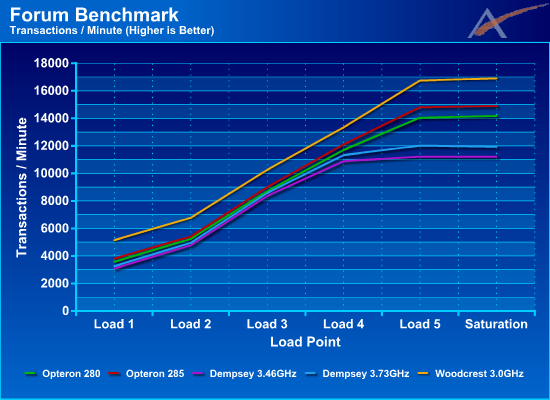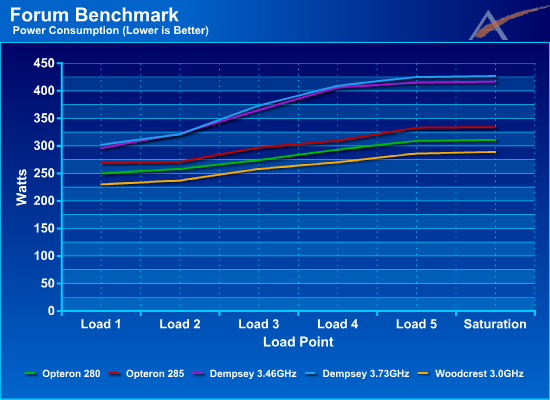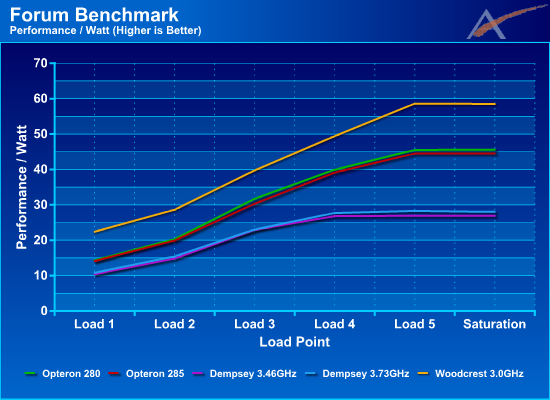Intel Woodcrest: the Birth of a New King
by Jason Clark & Ross Whitehead on July 13, 2006 12:05 AM EST- Posted in
- IT Computing
Forum Test results

Unlike the Dell DVD Store test, Woodcrest demonstrates a commanding lead at all load points. Woodcrest is able to lead the Opteron 285 by 10%-35% and Dempsey 3.73 by 18%-58%. The Forums test was harder to throttle at the lowest load point, thus the first load point results do not fit entirely into the expected linear model. In future reviews we may try and address this.

This graph is similar to the Dell Power results. Woodcrest is again the lowest consumer of power. Woodcrest leads the Opteron 285 by 13%-14%, and Dempsey 3.73 by 24%-34%.

Lower power and higher performance of course makes Woodcrest the clear leader at all load points in terms of Performance/Watt. It leads the Opteron 285 by 26%-58% and Dempsey 3.73 by 73%-108%. Again note that the Opteron 280 outperforms the Opteron 285 in terms of Performance/Watt.
Conclusion
It took a few years, which is normal for any architecture redesign, but we feel Intel has finally created a product that is not just competitive to the AMD Opteron. Woodcrest outperforms all of the competition in 2-way configurations, and it does so with lower power consumption. This combination leads to better Performance/Watt in all tested situations. Woodcrest not only outperforms it's predecessor by over 100% in Performance/Watt, but it outperforms Opteron by as much as 60% in Performance/Watt. In terms of straight performance the Woodcrest led the way by anywhere from 18 to 35% at higher system loads. We feel that Intel has the vision to continue this trend, as they have a clear roadmap for next year and beyond. Expect to see even further gains in 2007. How those parts will compete with future AMD products is unknown, but we have competition and that is always good for the consumer.

Unlike the Dell DVD Store test, Woodcrest demonstrates a commanding lead at all load points. Woodcrest is able to lead the Opteron 285 by 10%-35% and Dempsey 3.73 by 18%-58%. The Forums test was harder to throttle at the lowest load point, thus the first load point results do not fit entirely into the expected linear model. In future reviews we may try and address this.

This graph is similar to the Dell Power results. Woodcrest is again the lowest consumer of power. Woodcrest leads the Opteron 285 by 13%-14%, and Dempsey 3.73 by 24%-34%.

Lower power and higher performance of course makes Woodcrest the clear leader at all load points in terms of Performance/Watt. It leads the Opteron 285 by 26%-58% and Dempsey 3.73 by 73%-108%. Again note that the Opteron 280 outperforms the Opteron 285 in terms of Performance/Watt.
Conclusion
It took a few years, which is normal for any architecture redesign, but we feel Intel has finally created a product that is not just competitive to the AMD Opteron. Woodcrest outperforms all of the competition in 2-way configurations, and it does so with lower power consumption. This combination leads to better Performance/Watt in all tested situations. Woodcrest not only outperforms it's predecessor by over 100% in Performance/Watt, but it outperforms Opteron by as much as 60% in Performance/Watt. In terms of straight performance the Woodcrest led the way by anywhere from 18 to 35% at higher system loads. We feel that Intel has the vision to continue this trend, as they have a clear roadmap for next year and beyond. Expect to see even further gains in 2007. How those parts will compete with future AMD products is unknown, but we have competition and that is always good for the consumer.










59 Comments
View All Comments
Viditor - Thursday, July 13, 2006 - link
Thanks Jason...it's just that the power draw is such a central theme to the review, it would be nice to know exactly what and how things were being tested. Could you let us know what features and chipset were on the OEM Woodcrest system?
Cheers
FesterOZ - Thursday, July 13, 2006 - link
JasonBased on your own Extech tests, the 280 you previously tested here http://www.anandtech.com/showdoc.aspx?i=2644&p...">http://www.anandtech.com/showdoc.aspx?i=2644&p... was drawing a max of 265 watts for that database forum test at max load. Now the same CPU seems to be drawing 300+ Watts.
Can you please explain this variation?
johnsonx - Thursday, July 13, 2006 - link
Between the two platforms, the motherboards (Tyan 2882 vs 2891) are different with different chipsets (AMD+AMD vs NVidia+AMD), the software load is different (I presume even at apparent 100% load, there will be small power consumption differences depending on what the software actually does), and there is probably a power supply difference.Those factors combined could easily account for 40 or so watts.
FesterOZ - Thursday, July 13, 2006 - link
Sorry but I really have to disagree here. 40 Watts in a south bridge? Both tests the CPUS were maxed out.Viditor - Thursday, July 13, 2006 - link
Could you be more specific on the Intel OEM system specs? (we can look up the Tyan of course)I assume you used the same PSU for both systems...
Did you measure power draw at the wall?
MrKaz - Thursday, July 13, 2006 - link
Was this review/preview made by Intel?I mean:
-Charts have blue background (a la Intel). (There is one Anandtech symbol in the charts but could be Intel no difference).
-Charts with performance/watts, since when Anandtech review CPU based on those parameters? Never. Why now?
-.90nm CPU vs .65nm CPU - .65nm CPU wins, higher clock, lower consuming. No big surprise here, especially if this processor is derivates from a mobile one.
When AMD releases one socket F Opteron will be interesting, especially if = Intel with just half the cache size and 3 years "old" design on .90nm process.
fitten - Thursday, July 13, 2006 - link
Heh, by your standards then, the Pentium4s should have been faster than all since they are higher clock.
MrKaz - Thursday, July 13, 2006 - link
Intel.http://www.intel.com/performance/server/xeon/intth...">http://www.intel.com/performance/server/xeon/intth...
sprockkets - Thursday, July 13, 2006 - link
65nm smaller than 90nm, I would hope they consume less power. Still, Intel has always been good with power with the P6 derivatives.berat556 - Thursday, July 13, 2006 - link
I am not impressed with this latest review especially when you take into consideration how the intel is a 3.0GHZ processor while the opteron 285 is 2.6GHZ processor. I was so exited about Conroe but this latest benchmark made put my pre-order order on hold to see if Conroe will do what they said it would a 2.67GHZ win vs. a 2.8GHZ. Major bumper, it looks like woodcrest is still behing the opteron, maybe that is why dell still decided to go with AMD after Intel announced the core architecture.